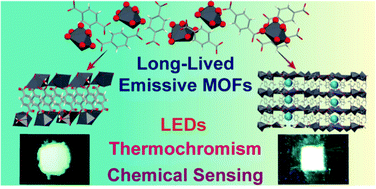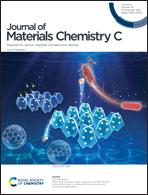Long-lived highly emissive MOFs as potential candidates for multiphotonic applications†
Abstract
Long-lived emissive materials based on room temperature phosphorescence (RTP) and thermally activated delayed fluorescence (TADF) are considered as the cornerstone of the development of optical sensors, security systems and solid-state lighting. Nevertheless, molecular systems with these properties are scarce because most of them suffer from aggregation caused quenching emission (ACQ). One approach to address this shortcoming is by inhibiting the molecular motions/vibrations by employing a fixed matrix as afforded by a metal–organic framework (MOF). There, the organic chromophores are confined in a crystalline framework, and the structure–property relationship can be designed to get RTP/TADF. Inspired by this, the present work explores the relationship between the linker arrangement and the physicochemical properties of two isochemical MOFs with different crystalline structures. The denser MOF exhibits a long-lived green RTP due to a hyperfine coupling of the linkers. On the other hand, the more porous MOF presents a long-lived temperature-dependent turquoise emission, reflecting the influence of the TADF. Hence, this study provides a huge advance about the potential of MOFs to undergo RTP and TADF emission, and at the same time, demonstrates their potential applicability in a wide range of photonic technologies, including physical and chemical sensing and the first example of a MOF-LED based on RTP-MOFs.



 Please wait while we load your content...
Please wait while we load your content...